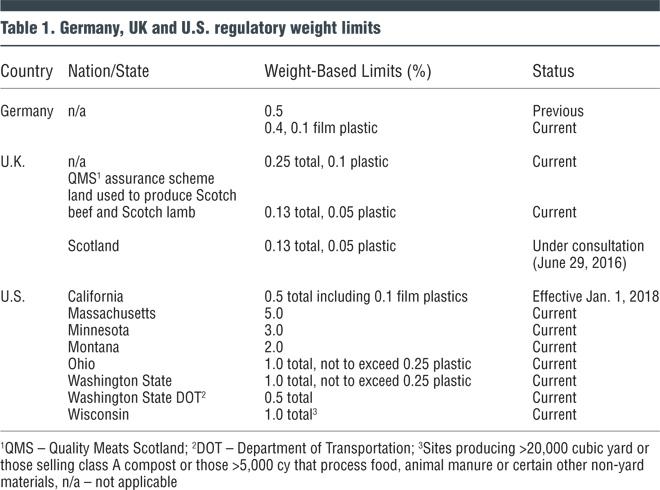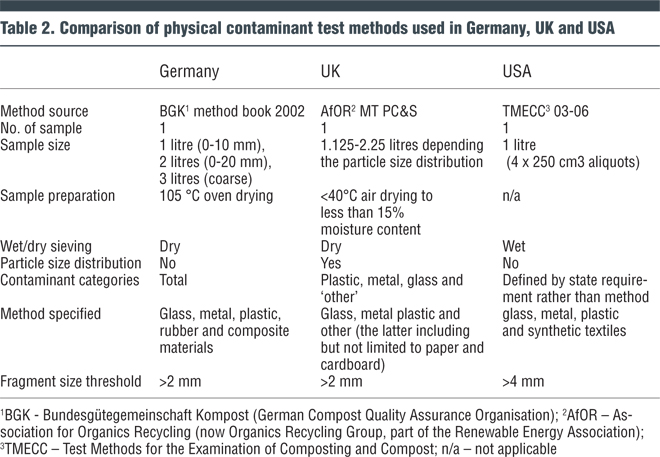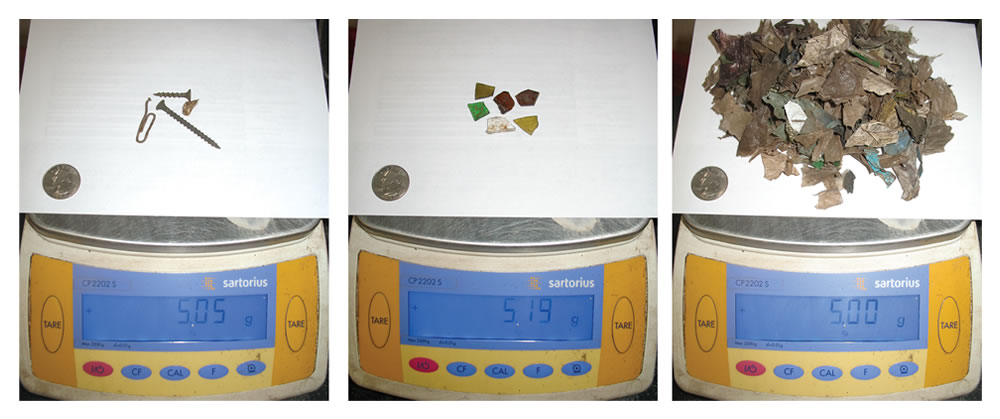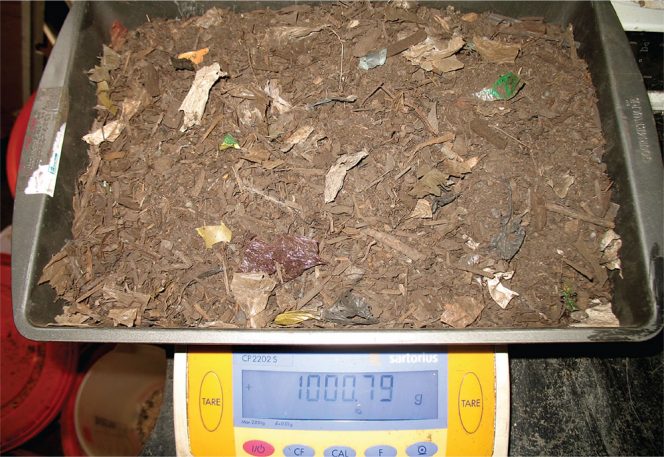Changes are in progress in multiple countries on weight-based limits for physical contaminants in composts. The net effect may be higher quality compost products.
Thomas J. Aspray
BioCycle September 2016
The quality of compost products is highly dependent on the quality of the feedstock materials. Therefore, considerable effort has been made in recent years to educate the public and stakeholder groups on feedstocks destined, either knowingly or unknowingly, for composting. As such measures start to have a positive effect, they hopefully will result in more consistent or even higher quality compost than is already produced. This in turn can lead to tighter limits for physical contaminants in compost.
In the United Kingdom (UK), for example, the Quality Meats Scotland (QMS) agricultural assurance scheme has successfully driven the physical contaminants limit for compost quality down by 50 percent on land used for producing Scotch beef and lamb branded meat (Table 1). Representing 90 percent of Scotland’s breeding cattle population and 80 percent of the breeding sheep flock, QMS’ influence is clear on the quality of compost going to the Scottish agricultural land bank (land suitable for compost application). The result appears to be the most stringent weight-based target for physical contaminants in compost products in the world. The limits set by QMS are being considered for wider implementation this year by the Scottish Environmental Protection Agency (SEPA) for regulating the handling and use of compost outputs in Scotland (SEPA, 2016).
Changes are also in progress elsewhere on limits for physical contaminants in composts. In the U.S., as of January 1, 2018, the limit for physical contaminants in compost will be lowered from 1.0 to 0.5 percent on a dry weight basis in the state of California, which mirrors the limit set by the Washington State Department of Transportation (WSDOT). A limit of 0.1 percent by weight will also be applied for film plastics in California, as they tend to have a significantly lower weight to surface area ratio compared to most other physical contaminants. (The California rule states: “no more than 20% by dry weight of this 0.5% shall be film plastic greater than 4 mm,” thus 0.5% x 20% = 0.1%.) A specific limit for film plastics should help to standardize the quality of different compost products. Similarly, a 0.1 percent by weight limit for film plastics was introduced in Germany at the beginning of 2016.
Weight Based Laboratory Testing
With fairly similar weight limits, there appears to be consistency between different countries in terms of the testing method used for physical contaminants. On a basic level this is true in that physical contaminant testing in the three countries mentioned involves screening, manual isolation of physical contaminant fragments, and quantification on a weight basis. However, when comparing individual country test methods a number of differences become apparent (Table 2). For example, in Germany and the UK, physical contaminant testing is carried out on dried or partially dried material, whereas in the U.S., fresh material is used for a wet-based sieving process.
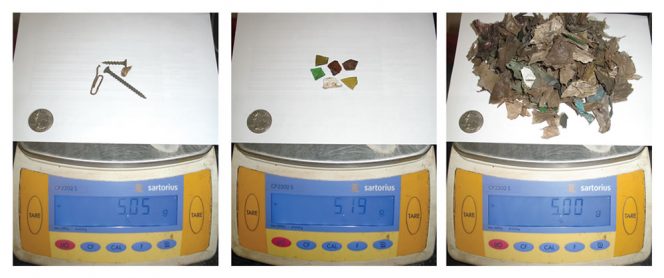
Photos of contaminants (from left to right) — metal, glass and film plastic. Each represents 0.5% of the total dry weight of the 1 kg of contaminated dry compost. Courtesy of Soil Control Lab
Another difference between the testing methods, and their interpretation in this particular case, is the materials considered as physical contaminants. None of the three published methods have an exhaustive “list” of acceptable contaminants, leaving decision making in the hands of the laboratories themselves.
An interesting difference is also seen between the UK and German methods where paper is viewed differently — it’s a physical contaminant in the UK but not in Germany. The U.S. method does not indicate either way, however discussion with several in the U.S. composting industry indicates that paper can be a physical contaminant. For example, the highly water-resistant “product stickers” on fruits and vegetables don’t degrade in the composting process and are a widely reported problem in the U.S.
This author’s opinion is that all paper found in compost products should be reported as a physical contaminant given that issue with physical contamination is mainly one of visual perception — if biodegradable paper is visible then the question is whether the composting process has done what it was supposed to. The same argument stands for compostable plastic, and is upheld by the German method, which states that materials produced from “biologically degradable polymers” should be considered as physical contaminants if visible in the compost product.
The inclusion of paper outright as a physical contaminant does, however, present another issue for the laboratories: Determining the point at which fragments should no longer be considered physical contaminants but rather part of the compost itself. Recent research in the UK has started to highlight this issue, with variability reported by commercial laboratories testing compost samples spiked with paper fragments previously recovered from finished composts (Echavarri-Bravo et al., 2016).
Area Based Quantification
Although physical contaminants in composts are largely assessed on a weight basis both commercially and in research publications, an alternative is surface area based quantification. In fact, industry protocols exist for surface area quantification of physical contaminants in Germany and the U.S. In both protocols, isolated physical contaminant fragments are spread out on a surface for scanning. The scanned image is then processed using image analysis software to determine the collective fragment surface area.
The TMECC (2002) protocol for surface area quantification is limited to film plastics and not used in a regulatory manner in the U.S. By comparison, in Germany surface area quantification is used for all physical contaminant types and has recently become mandatory for all compost samples. Used in conjunction with weight based determination, surface area quantification provides a potentially more robust approach to compost physical contaminant assessment. However, as an add-on to the weight based approach, this obviously has cost implications for what is already a labor-intensive method.
Sample Heterogeneity
Despite their differences, the universal issue with the physical contaminant tests discussed here is the quantity of sample used to reflect a batch of compost which, in the UK at least, can be anything up to 5,000 cubic meters (BS EN 12579). All compost quality parameters (e.g. stability, heavy metals, etc.) display a degree of variability given the inherent heterogeneous nature of compost; however, physical contamination is one often isolated out by producers.
As already eluded to, the problem at this present time is the labor intensive nature of the current tests, meaning it would be impractical to manually process a significantly large sample size in the laboratory. Similarly, analysis of multiple grab samples from a compost batch is likely to be unpopular with producers due to cost implications. The answer isn’t clearly obvious. Perhaps we need to let the (compost) dust settle first from all the changes discussed in this article before tackling this one!
Dr. Thomas Aspray is Assistant Professor of microbiology at Heriot-Watt University and a consultant specializing in organic waste management. He is independent auditor for the UK compost certification scheme and biogas certification scheme appointed laboratories.
